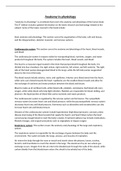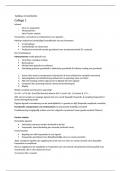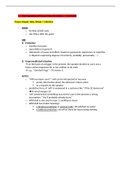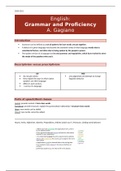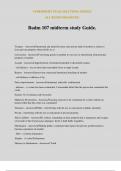Digestive System
liver
gallbladder
Functions of the Digestive System pancreas
✓ The digestive system is a complex set of
organs, glands, and ducts that work together to Layers of Digestive Tract Wall
transform food into nutrients for cells. ❖ The layers of the tract wall are also termed
✓ Food is taken into the digestive system, where tunics.
it is broken down into smaller and smaller Mucosa:
particles. ➢ innermost layer
✓ Enzymes break the particles down into small ➢ secretes mucus
molecules, which are absorbed into the blood ➢ (mucous membrane) has epithelium, lamia
and transported all over the body. propria, and muscularis mucosae along with
Digestive System Functions lymphatic nodule, intestinal gland
1. Ingestion and mastication – ingestion is the Submucosa:
consumption of solid or liquid food. Mastication ➢ above mucosa
is chewing. ➢ contains blood vessels, nerves, small glands
2. Propulsion and mixing - Propulsion is the Muscularis:
movement of food from one end of the digestive ➢ above submucosa
tract to the other. Mixing is the movement of ➢ longitudinal, circular, and oblique muscles
food back and forth in the digestive tract to mix ➢ has circular muscle layer and longitudinal
it with enzymes and facilitate absorption. muscle layer along with gland in submucosa
3. Digestion and secretion - Digestion is the with ducts from glands
mechanical and chemical breakdown of large ➢ Enteric plexus has myenteric plexus and
molecules into smaller molecules that can be submucosal plexus
absorbed. Secretion is the addition of liquids, Serosa/adventitia:
enzymes, and mucus to the ingested food. ➢ outermost layer
4. Absorption - the movement of molecules out of ➢ If peritoneum is present called serosa
the digestive tract and into the blood or ➢ If no peritoneum then called adventitia
lymphatic system. ➢ (serous membrane: visceral peritoneum) has
5. Elimination - Elimination is the removal of connective tissue and simple squamous
undigested material, such as fiber from food, epithelium
plus other waste products from the body as
➢ The mesentery has blood vessels, lymphatic
feces.
vessel, and nerve.
Anatomy of the Digestive System
The digestive system consists of the digestive Peritoneum
tract, plus specific associated organs. Visceral peritoneum – or serosa, is the serous
The digestive tract is also referred to as the membrane that covers the organs.
GIT (gastrointestinal tract) Parietal peritoneum – is the serous membrane that
The tract is one long tube from the mouth to lines the wall of the abdominal cavity
the anus.
Mesenteries – connective tissue sheets that hold
organs in place in the abdominal cavity
Digestive Tract
oral cavity (mouth) Lesser omentum – mesentery connecting lesser
pharynx curvature of stomach to liver and diaphragm
esophagus Greater omentum – mesentery connecting greater
stomach curvature of stomach to transverse colon and
small intestines posterior body wall
large intestines
anus Liver, lesser omentum, stomach, pancreas
(retroperitoneal), kidney (retroperitoneal), rectum
Associated Organs (retroperitoneal), mesentery proper, transverse colon,
duodenum (retroperitoneal), peritoneal cavity containing
❖ The digestive system includes some associated peritoneal fluid, greater omentum, parietal peritoneum,
organs, not directly in the digestive tract, that omental bursa, small intestine, and urinary bladder
have ducts that lead into the tract. (retroperitoneal).
salivary glands
, Oral Cavity Pharynx
Lips - muscular structures, formed by the orbicularis Throat – connects the mouth to the esophagus
oris muscle and covered by skin. It has three parts:
Cheeks - lateral walls of the oral cavity, within the 1. nasopharynx
cheeks are the buccinator muscles which flatten the 2. oropharynx
cheeks against the teeth. 3. laryngopharynx
Tongue - large, muscular organ that occupies most
Esophagus
of the oral cavity.
Tube that connects the pharynx to the
The tongue moves food in the mouth and, in stomach
cooperation with the lips and cheeks, holds the food Transports food to the stomach
in place during mastication. Joins stomach at cardiac opening
Heartburn:
Teeth
➢ a common symptom of acid reflux, a condition
32 teeth in normal adult where some of the stomach contents travel
Incisors, canine, premolars, molars, wisdom back up into the esophagus, or food pipe
20 primary (deciduous) teeth ➢ occurs when gastric juices regurgitate into
Each tooth has crown, cusp, neck, root esophagus
The bulk of the tooth is formed by a cellular ➢ It creates a burning pain in the lower chest
tissue called dentin ➢ caused by caffeine, smoking, or eating or
In the crown of the tooth, the dentin is covered drinking in excess
by an extremely hard, acellular enamel. ➢ Persistent acid reflux that happens more than
Center of tooth is pulp cavity filled with a twice per week is what experts call
material called pulp, which consists of blood gastroesophageal reflux disease (GERD).
vessels, nerves, and connective tissue
Teeth are held in place within pockets in the Swallowing
bone, called alveoli ▪ also called deglutition, the act of passing food
Dental caries (cavities) is breakdown of from the mouth, by way of the pharynx (or
enamel by acids from bacteria throat) and esophagus, to the stomach.
Palate, Hard palate and Soft palate Voluntary phase:
Palate – roof of oral cavity ➢ bolus (mass of food) formed in mouth and
Hard palate – anterior part made of bone pushed into oropharynx
Soft palate – posterior part consists of skeletal Pharyngeal phase:
muscle and connective tissue ➢ swallowing reflex initiated when bolus
stimulates receptors in oropharynx
Salivary Glands
Esophageal phase:
Produce saliva which is a mixture of serous
➢ moves food from pharynx to stomach
(watery) and mucous fluids
Peristalsis:
Keeps the oral cavity moist
Needed for normal speech ➢ wave-like contractions move food through
Dissolves food particles so they can be tasted digestive tract
Protects against bacteria and neutralizes pH ➢ bolus is moved forward by a wave of
Begins the process of digestion relaxation and a wave of contraction pushes at
the back of the bolus to move it forward.
Parotid – serous glands anterior to each ear.
Submandibular – produce more serous than Stomach
mucous secretions, found along the inferior border
Located in abdomen
of the mandible.
Storage tank for food
Sublingual – produce primarily mucous and lie
below the mucous membrane in the floor of the oral Can hold up to 2 liters of food
cavity. Produces mucus, hydrochloric acid, protein
▪ Serous portion of saliva contains enzymes digesting enzymes
Amylase - Digestive enzyme that breaks down Contains a thick mucus layer that lubricates
carbohydrates and protects epithelial cells on stomach wall
from acidic pH (3)
Lysozyme - Enzymes that are active against bacteria
▪ Mucous portion contains mucin for lubrication
liver
gallbladder
Functions of the Digestive System pancreas
✓ The digestive system is a complex set of
organs, glands, and ducts that work together to Layers of Digestive Tract Wall
transform food into nutrients for cells. ❖ The layers of the tract wall are also termed
✓ Food is taken into the digestive system, where tunics.
it is broken down into smaller and smaller Mucosa:
particles. ➢ innermost layer
✓ Enzymes break the particles down into small ➢ secretes mucus
molecules, which are absorbed into the blood ➢ (mucous membrane) has epithelium, lamia
and transported all over the body. propria, and muscularis mucosae along with
Digestive System Functions lymphatic nodule, intestinal gland
1. Ingestion and mastication – ingestion is the Submucosa:
consumption of solid or liquid food. Mastication ➢ above mucosa
is chewing. ➢ contains blood vessels, nerves, small glands
2. Propulsion and mixing - Propulsion is the Muscularis:
movement of food from one end of the digestive ➢ above submucosa
tract to the other. Mixing is the movement of ➢ longitudinal, circular, and oblique muscles
food back and forth in the digestive tract to mix ➢ has circular muscle layer and longitudinal
it with enzymes and facilitate absorption. muscle layer along with gland in submucosa
3. Digestion and secretion - Digestion is the with ducts from glands
mechanical and chemical breakdown of large ➢ Enteric plexus has myenteric plexus and
molecules into smaller molecules that can be submucosal plexus
absorbed. Secretion is the addition of liquids, Serosa/adventitia:
enzymes, and mucus to the ingested food. ➢ outermost layer
4. Absorption - the movement of molecules out of ➢ If peritoneum is present called serosa
the digestive tract and into the blood or ➢ If no peritoneum then called adventitia
lymphatic system. ➢ (serous membrane: visceral peritoneum) has
5. Elimination - Elimination is the removal of connective tissue and simple squamous
undigested material, such as fiber from food, epithelium
plus other waste products from the body as
➢ The mesentery has blood vessels, lymphatic
feces.
vessel, and nerve.
Anatomy of the Digestive System
The digestive system consists of the digestive Peritoneum
tract, plus specific associated organs. Visceral peritoneum – or serosa, is the serous
The digestive tract is also referred to as the membrane that covers the organs.
GIT (gastrointestinal tract) Parietal peritoneum – is the serous membrane that
The tract is one long tube from the mouth to lines the wall of the abdominal cavity
the anus.
Mesenteries – connective tissue sheets that hold
organs in place in the abdominal cavity
Digestive Tract
oral cavity (mouth) Lesser omentum – mesentery connecting lesser
pharynx curvature of stomach to liver and diaphragm
esophagus Greater omentum – mesentery connecting greater
stomach curvature of stomach to transverse colon and
small intestines posterior body wall
large intestines
anus Liver, lesser omentum, stomach, pancreas
(retroperitoneal), kidney (retroperitoneal), rectum
Associated Organs (retroperitoneal), mesentery proper, transverse colon,
duodenum (retroperitoneal), peritoneal cavity containing
❖ The digestive system includes some associated peritoneal fluid, greater omentum, parietal peritoneum,
organs, not directly in the digestive tract, that omental bursa, small intestine, and urinary bladder
have ducts that lead into the tract. (retroperitoneal).
salivary glands
, Oral Cavity Pharynx
Lips - muscular structures, formed by the orbicularis Throat – connects the mouth to the esophagus
oris muscle and covered by skin. It has three parts:
Cheeks - lateral walls of the oral cavity, within the 1. nasopharynx
cheeks are the buccinator muscles which flatten the 2. oropharynx
cheeks against the teeth. 3. laryngopharynx
Tongue - large, muscular organ that occupies most
Esophagus
of the oral cavity.
Tube that connects the pharynx to the
The tongue moves food in the mouth and, in stomach
cooperation with the lips and cheeks, holds the food Transports food to the stomach
in place during mastication. Joins stomach at cardiac opening
Heartburn:
Teeth
➢ a common symptom of acid reflux, a condition
32 teeth in normal adult where some of the stomach contents travel
Incisors, canine, premolars, molars, wisdom back up into the esophagus, or food pipe
20 primary (deciduous) teeth ➢ occurs when gastric juices regurgitate into
Each tooth has crown, cusp, neck, root esophagus
The bulk of the tooth is formed by a cellular ➢ It creates a burning pain in the lower chest
tissue called dentin ➢ caused by caffeine, smoking, or eating or
In the crown of the tooth, the dentin is covered drinking in excess
by an extremely hard, acellular enamel. ➢ Persistent acid reflux that happens more than
Center of tooth is pulp cavity filled with a twice per week is what experts call
material called pulp, which consists of blood gastroesophageal reflux disease (GERD).
vessels, nerves, and connective tissue
Teeth are held in place within pockets in the Swallowing
bone, called alveoli ▪ also called deglutition, the act of passing food
Dental caries (cavities) is breakdown of from the mouth, by way of the pharynx (or
enamel by acids from bacteria throat) and esophagus, to the stomach.
Palate, Hard palate and Soft palate Voluntary phase:
Palate – roof of oral cavity ➢ bolus (mass of food) formed in mouth and
Hard palate – anterior part made of bone pushed into oropharynx
Soft palate – posterior part consists of skeletal Pharyngeal phase:
muscle and connective tissue ➢ swallowing reflex initiated when bolus
stimulates receptors in oropharynx
Salivary Glands
Esophageal phase:
Produce saliva which is a mixture of serous
➢ moves food from pharynx to stomach
(watery) and mucous fluids
Peristalsis:
Keeps the oral cavity moist
Needed for normal speech ➢ wave-like contractions move food through
Dissolves food particles so they can be tasted digestive tract
Protects against bacteria and neutralizes pH ➢ bolus is moved forward by a wave of
Begins the process of digestion relaxation and a wave of contraction pushes at
the back of the bolus to move it forward.
Parotid – serous glands anterior to each ear.
Submandibular – produce more serous than Stomach
mucous secretions, found along the inferior border
Located in abdomen
of the mandible.
Storage tank for food
Sublingual – produce primarily mucous and lie
below the mucous membrane in the floor of the oral Can hold up to 2 liters of food
cavity. Produces mucus, hydrochloric acid, protein
▪ Serous portion of saliva contains enzymes digesting enzymes
Amylase - Digestive enzyme that breaks down Contains a thick mucus layer that lubricates
carbohydrates and protects epithelial cells on stomach wall
from acidic pH (3)
Lysozyme - Enzymes that are active against bacteria
▪ Mucous portion contains mucin for lubrication

